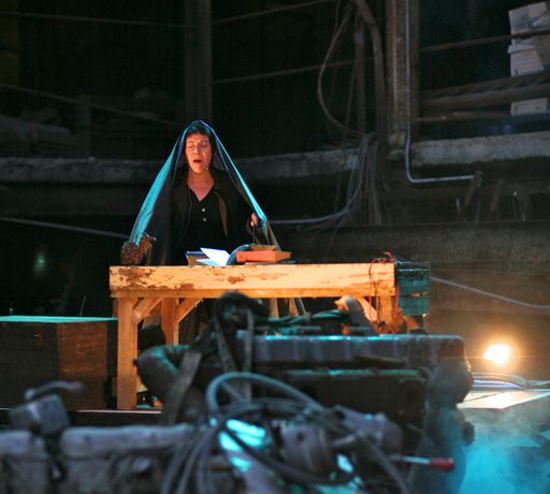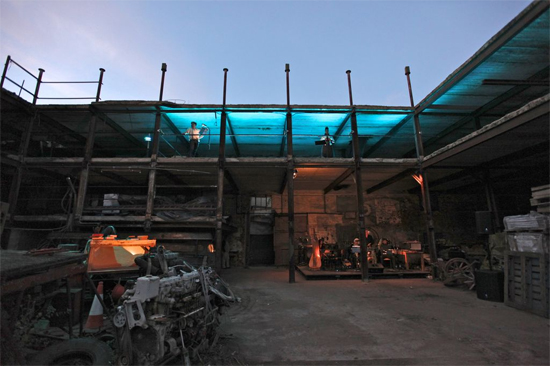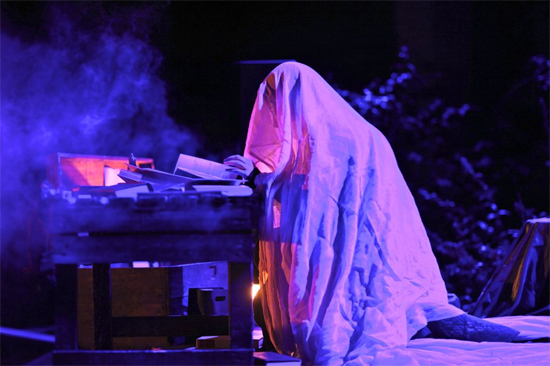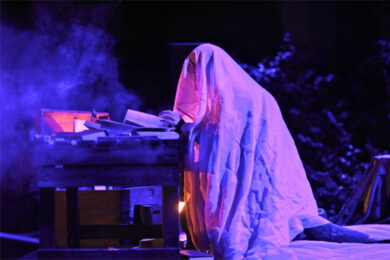Under a clear night sky, with bats flapping overhead and stars glinting in the firmament, surrounded by the ruins of a derelict building in Snape’s famous Maltings, a handful of hardy but lucky souls are treated to an "opera" of such mysterious proportions it seems reductive to name it as such. Indeed, composer David Toop says as much in his pre-show chat, and Star-Shaped Biscuit clearly eschews the archetypes of traditional opera, not just in its instrumentation and performance space, but via its very construction as a piece of music.
The story behind Star-Shaped Biscuit, such as it is, is appropriately and typically oblique: Dora Maar, photographer, poet and once Picasso’s lover, is possibly the last human left living on a dying planet. From a drowning island, she contemplates her past, transported back in time in a Proustian fashion when she discovers an old star-shaped biscuit in her case. Meanwhile, two ghosts – 1920s explorer/adventurer Seabrook and a Vernon Lee character, Euphrosine – emerge from the shadows of her home to harangue, chat and comment on Dora’s life, seeing it as a means to understand their own listless scheintot.
To represent this isolated world-between-worlds, Toop and the people at Aldeburgh Music selected one of the abandoned, derelict and soon-to-be-renovated buildings at the edge of the Maltings, and have done an amazing job of converting it into a space where Toop’s excellent collection of musicians and singers can elegantly recreate the haunted island of faded memories occupied by Dora Maar and her phantomatic companions. For long passages during Star-Shaped Biscuit, it feels like audience and performers are alone in the world, except for the bats, the bugs and the endless black sky. In terms of its set-up, doggedly away from conventional "musical theatre" or opera, Star-Shaped Biscuit is a triumph.
At times, however, Star-Shaped Biscuit is frustratingly abstract, especially as the lyrics are not always easily discernible. Musically, the compositions highlight Toop’s love of improvisation, with a hugely talented quintet of musicians producing unpredictable sonic shapes with an array of percussion, strings and wind instruments. They’re situated beneath layers of digital noise, elusive sound effects, sampled voices and the kind of hauntological haze found on albums by The Caretaker and Grouper, which only serves to highlight the piece’s underlying theme of memory, as triggered in Dora by not just the biscuit but also her notebooks and a painting of her by her former lover, Picasso.

As Dora Maar, Lore Lixenberg brings suitable amounts of anguished pathos to the fore, especially when remembering the great painter’s cruelty. Her voice traverses an impressive range, including, during the "opera"’s central moment that sees her relive a nervous breakdown and the ensuing shock treatment, a series of howls and cries that could make Diamanda Galas seem restrained. At other times, her moody moan seems lifted from the tradition of unexpectedly sinister and deceptively melancholic female vocalisation favoured by horror film directors when wanting to suggest haunted, threatening territory (see Coppola’s otherwise useless version of Dracula), which again fits acutely with Toop’s intangible, ectoplasmic scenario.
More interesting are the two ghosts, Seabrook and Euphrosine, who stand on the first floor of the derelict building, the exposed space transformed into a balcony from which they contemplate Dora Maar. Euphrosine, portrayed by Elaine Mitchener, is the more thoughtful and compassionate ghost, apparently seeing in Dora something of a mirror image of herself. Brash and belligerent, Seabrook is in defiance of death, something reflected in the music during his solo parts by fractured post-techno beats and edgy post-rock atmospherics, the closest Star-Shaped Biscuit comes to any real driving force. Jamie McDermott possesses one of the most incredible voices I’ve ever heard, one that rises from low-end moan to operatic wail in seconds, like a more dexterous Antony Hegarty.

The two ghosts’ musings are alternately unsettling and pensive, but again the difficulty in deciphering the lyrics can be a problem. However, all three singers are wonderfully talented, and through their emotive delivery and the recurrence of words like "loss", "loneliness" and "memory", succeed in creating an atmosphere so palpable that direct comprehension is almost superfluous. As the piece winds down to its close, the two ghosts disappear and Dora remains to contemplate whether to join them. After all, as the hesitant, whispery music suggests, ghosts are all around us and, if she is indeed the last human, her memories and the phantoms of past individuals suggest she will never be alone. And, surrounded by the sounds of disembodied voices and music, lost under a sea of stars across which dance nature’s quiet fliers, neither will Toop’s audience.
Star-Shaped Biscuit will not be to everyone’s taste, for it is elusive and oblique almost to the point of becoming hard to grasp, whilst the mixture of improvised and electro-acoustic music is anything but demonstrative in the manner of "traditional" opera. The real triumph behind Toop’s work is the way it incorporates its very performance space into the piece’s spectrum, transforming what is little more than a ruin into a realm in which dreams and illusions, memories and phantoms, become a nebulous form of musical reality.



